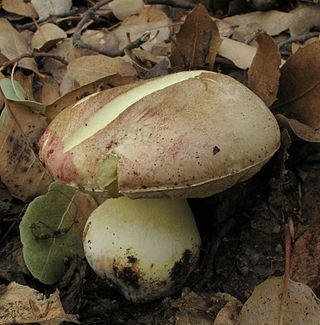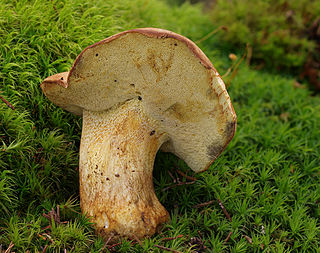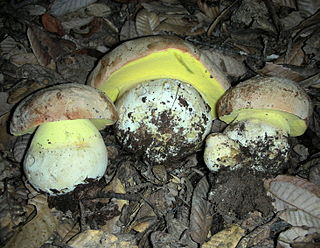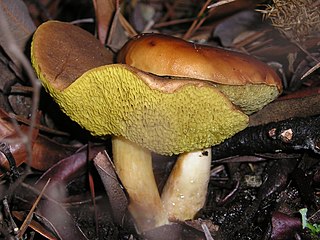
The Boletaceae are a family of mushroom-forming fungi, primarily characterised by small pores on the spore-bearing hymenial surface, instead of gills as are found in most agarics. Nearly as widely distributed as the agarics, the family is renowned for hosting some prime edible species highly sought after by mushroom hunters worldwide, such as the cep or king bolete . A number of rare or threatened species are also present in the family, that have become the focus of increasing conservation concerns. As a whole, the typical members of the family are commonly known as boletes.

Rubroboletus pulcherrimus—known as Boletus pulcherrimus until 2015—is a species of mushroom in the family Boletaceae. It is a large bolete from Western North America with distinguishing features that include a netted surface on the stem, a red to brown cap and stem color, and red pores that stain blue upon injury. Until 2005 this was the only bolete that has been implicated in the death of someone consuming it; a couple developed gastrointestinal symptoms in 1994 after eating this fungus with the husband succumbing. Autopsy revealed infarction of the midgut.

Butyriboletus appendiculatus is an edible pored mushroom that grows under oaks and other broad leaved trees such as beech. It is commonly known as the butter bolete. It often grows in large colonies beneath the oak trees, and is frequently found cohabiting with old oaks in ancient woodland. It is relatively rare in Britain. Its stipe and pores are often bright yellow and its flesh stains bright blue when cut or bruised.

Boletus fibrillosus is a basidiomycete fungus of the genus Boletus found in western North America. The fruiting bodies are found in mixed coastal forests in the fall, usually singly or in small groups. The cap is up to 17 cm wide, buff to brown to dark brown in color, and has a wrinkled to finely fibrous texture. The tubes are yellow, while the flesh is white to buff and does not stain when cut. The stem is yellowish at the top, brown otherwise, with a reticulate texture, and mycelium enshrouding the bottom. The holotype was collected in Mendocino County, California. The species is edible, but considered to have inferior taste to other edible boletes such as B. edulis, which it is often confused with.

Butyriboletus regius, commonly known as the royal bolete or red-capped butter bolete, is a basidiomycete fungus of the genus Boletus found in China and Europe. B. regius has a pink cap, yellow flesh, and a reticulate pattern on the stem. Harry D. Thiers described a similar mushroom from California as B. regius, though it is not the same species. B. regius in Europe does not stain when exposed to air, or stains weakly, but the California species stains blue. Both European and California species are considered choice edibles.

Butyriboletus roseopurpureus is a species of fungus in the family Boletaceae. Found in eastern North America, it was officially described in 2000 as a species of Boletus, and transferred to the genus Butyriboletus in 2015.
Butyriboletus peckii is a fungus of the genus Butyriboletus native to eastern North America. It was first described by Charles Christopher Frost in 1878. Until 2014, it was known as Boletus peckii. Recent changes in the phylogenetic framework of the Boletaceae prompted the transfer of this species, along with several other related boletes, including Caloboletus calopus, to the genus Caloboletus. In 2015, Kuan Zhao and colleagues published analysis that demonstrated that the bolete belongs to Butyriboletus, closely related to Butyriboletus pulchriceps.

Butyriboletus is a genus of fungi in the family Boletaceae. The genus was circumscribed in 2014 by mycologists David Arora and Jonathan L. Frank to accommodate "butter bolete" species that were shown by molecular analysis to be phylogenetically distinct from Boletus. Butyriboletus contains 24 ectomycorrhizal species found in Asia, Europe, North America and north Africa.

Butyriboletus querciregius is a pored mushroom in the genus Butyriboletus. Found in California, where it grows in a mycorrhizal association with coast live oak, it was described as new to science in 2014.
Butyriboletus roseoflavus is a pored mushroom in the genus Butyriboletus found in Asia. It was originally described in 2013 as a species of Boletus, but was transferred the following year to the newly created genus Butyriboletus.
Butyriboletus sanicibus is a pored mushroom in the genus Butyriboletus. Found in China where it grows in association with Yunnan pine, it was described as a new species in 2014.

Butyriboletus subappendiculatus is a pored mushroom in the family Boletaceae. This European species was originally described as a species of Boletus in 1979, but later transferred to Butyriboletus in 2014. It is considered endangered in the Czech Republic.
Butyriboletus yicibus is a pored mushroom in the genus Butyriboletus. Found Yunnan, China, where it grows in association with Yunnan pine, it was described as a new species in 2014.

Butyriboletus brunneus is a pored mushroom in the family Boletaceae. This North American species was originally described by Charles Horton Peck in 1890 as a variety of Boletus speciosus.
Butyriboletus ventricosus is a pored mushroom in the family Boletaceae. An Asian species, it was originally described in 2013 as a species of Boletus, but transferred to the newly created genus Butyriboletus the following year.

Butyriboletus fuscoroseus is a pored mushroom in the family Boletaceae. It was formerly considered a species of Boletus, but in 2014 was transferred to the newly created genus Butyriboletus. Boletus pseudoregius, a European taxon originally described as a subspecies of Boletus appendiculatus in 1927, is a synonym. B. fuscoroseus is considered critically endangered in the Czech Republic.

Butyriboletus persolidus is a pored mushroom in the family Boletaceae. Found in California, where it grows in a mycorrhizal association with coast live oak, it was described as new to science in 2014.

Butyriboletus primiregius is a pored mushroom in the family Boletaceae. Found in California, where it grows in a mycorrhizal association with fir, it was described as new to science in 2014.

Boletus amyloideus is a rare species of bolete fungus in the family Boletaceae. It was described as new to science in 1975 by mycologist Harry D. Thiers, from collections made in California. It fruit bodies have a convex to somewhat flattened reddish-brown cap measuring 3–6 cm (1.2–2.4 in) in diameter. The pore surface on the cap underside is bright yellow, with small angular pores and tubes measuring 4–8 mm long. The spore print is olive-brown; basidiospores are smooth, amyloid, spindle shaped to ellipsoid, and have dimensions of 13–16 by 4.5–5.5 µm. The bolete is known only from coastal California, where it grows on the ground in mixed forests. Its edibility is unknown.













